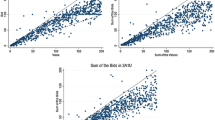Abstract
Campbell (J Econ Theory 82:425–450, 1998) develops a self-enforced collusion mechanism in simultaneous auctions based on complete comparative cheap talk and endogenous entry, with two bidders. His result is difficult to generalize to an arbitrary number of bidders, since the entry-decision stage of the game is characterized by strategic substitutes. This paper analyzes more-than-two-bidder, symmetric-prior cases. Two results are proved: (1) as the number of objects grows large, a full comparative cheap talk equilibrium exists and it yields asymptotically fully efficient collusion; and (2) there is always a partial comparative cheap talk equilibrium. All these results are supported by intuitive equilibria at the entry-decision stage (J Econ Theory 130:205–219, 2006; Math Soc Sci 2008, forthcoming). Numerical examples suggest that full comparative cheap talk equilibria are not uncommon even with few objects.
Similar content being viewed by others
References
Albano, G.L., Romano, F., Lovo, S.: On some collusive and signaling equilibria in ascending auctions for multiple objects, The Fondazione Eni Enrico Mattei Note di Lavoro Series 62.2001 (2001)
Aoyagi M.: Bid rotation and collusion in repeated auctions. J Econ Theory 112, 79–105 (2003)
Armstrong M.: Optimal multi-object auctions. Rev Econ Stud 67, 455–481 (2000)
Blume, A., Heidhues, P.: Private monitoring in auctions. In: 13th WZB Conference on Markets and Political Economy: Collusion and Cartels (2004)
Brusco S., Lopomo G.: Collusion via signaling in simultaneous ascending bid auctions with heterogeneous objects, with and without complementarities. Rev Econ Stud 69, 407–436 (2002)
Campbell C.M.: Coordination in auctions with entry. J Econ Theory 82, 425–450 (1998)
Celik G., Yilankaya O.: Optimal Auctions with Participation Costs, mimeo. University of British Columbia, Vancouver, BC (2005)
Chakraborty A., Harbaugh R.: Comparative cheap talk. J Econ Theory 132, 70–94 (2007)
Engelbrecht-Wiggans R., Kahn C.: Low revenue equilibria in simultaneous ascending price auctions. Manage Sci 51, 508–518 (2005)
Grimm V., Riedel F., Wolfstetter E.: Low price equilibrium in multi-unit auctions: the GSM spectrum auction in Germany. Int J Ind Organ 21, 1557–1569 (2003)
Levin D., Smith J.L.: Equilibrium in auctions with entry. Am Econ Rev 84, 585–599 (1994)
Lu, J.: Auction design with opportunity cost. Econ Theory, forthcoming (2008a)
Lu, J.: Why a simple second-price auction induces efficient endogenous entry. Theory Decis, forthcoming (2008b)
McAfee R.P., McMillan J.: Bidding rings. Am Econ Rev 82, 579–599 (1992)
Menezes F.M., Monteiro P.K.: Auctions with endogenous participation. Rev Econ Des 5, 71–89 (2000)
Miralles A.: Easy Collusion Mechanisms in Auctions with Entry, Mimeo. Boston University, Boston, MA (2005)
Miralles, A.: Intuitive and noncompetitive equilibria in weakly efficient auctions with entry costs, Math Soc Sci, forthcoming (2008)
Pesendorfer M.: A study of collusion in first-price auctions. Rev Econ Stud 67, 381–411 (2000)
Skrzypacz A., Hopenhayn H.: Tacit collusion in repeated auctions. J Econ Theory 114, 153–169 (2004)
Stegeman M.: Participation costs and efficient auctions. J Econ Theory 71, 228–259 (1996)
Tan G., Yilankaya O.: Equilibria in second price auctions with participation costs. J Econ Theory 130, 205–219 (2006)
Author information
Authors and Affiliations
Corresponding author
Additional information
Antonio Miralles is grateful to Hsueh-Lyhn Huynh, Bart Lipman, Zvika Neeman, Gregory Pavlov and an anonymous referee for their comments and suggestions. During the research, he received financial support from the Spanish Ministry of Education (SEJ2006-04985), the Fulbright Commission and Boston University.
Rights and permissions
About this article
Cite this article
Miralles, A. Self-enforced collusion through comparative cheap talk in simultaneous auctions with entry. Econ Theory 42, 523–538 (2010). https://doi.org/10.1007/s00199-008-0403-3
Received:
Accepted:
Published:
Issue Date:
DOI: https://doi.org/10.1007/s00199-008-0403-3




